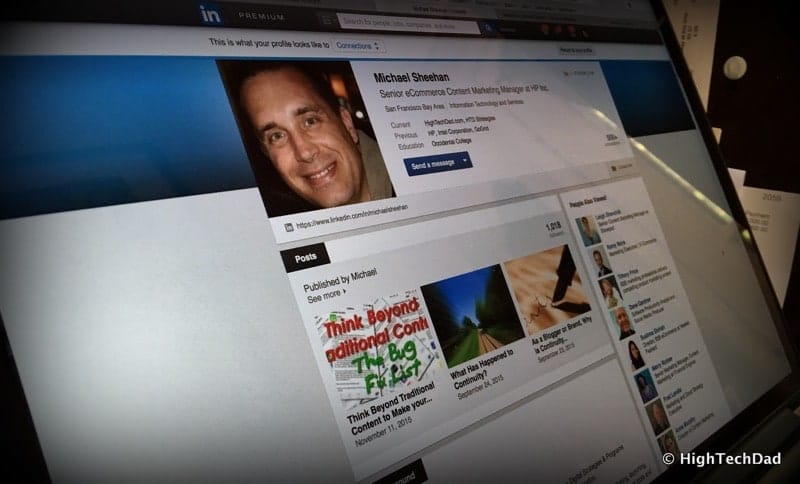I received an interesting question from one of my readers, Ed, recently which is both timely as well as a hot topic for any professional. It had to do with how to raise one’s visibility within social media or even thought-leadership in order to position oneself a bit more “above the fold” when searching for one’s next success or opportunity. This is an important topic, especially when trying to stand out to recruiters and hiring managers. While I’m not an expert, in fact, I’m currently looking for my next opportunity as well, the subject got me thinking on some advice for Ed, others and even rhetorically for me. So I thought I would share my ideas.
Ed writes:
“I’m hoping you can point me in the right direction. I am a tech professional (also a fellow tech-Dad) who has very recently become less than employed. I’m told by recruiters that I really need to be much more active within social media – and not just re-posting articles. So, to get a little name recognition, I’d like to post an article or two somewhere (more on the irreverent tech side than super serious stuff) and was wondering if you had any ideas for me? I’m not looking to make a living doing this (I’m afraid I’d have a hard time coming up with that much material!), but I could use a little name-brand awareness bump.”
There are many interesting points here that I would like to address. These are items that any professional, regardless of what state their career is in, should think about at one point or another, whether they are actively seeking employment or just fine-tuning their social media and personal brand presence for later. Obviously, I can’t cover everything in a single blog post, so the points reflected below are what I believe to be the most important at least for me.
Here are a list of direct & indirect ways to promote yourself:
- Discover what makes you unique
- Make sure your social profiles and sharing reflect your uniqueness and passion
- Don’t be bland or general – focus!
- Learn to be a story-teller
Let’s dive a bit deeper into these.
Discover what makes you unique
(source: commons.wikimedia.org)
This is probably the hardest item on the list. But it is really the first one you should do. How do you stand out amidst a sea of candidates, resumes and people clamoring for a few seconds of attention? You need to figure out what makes you unique. Once you can articulate this clearly, differentiating yourself from others becomes just a bit easier.
But it is not easy.
Earlier in my career, I positioned myself as “the guy who could talk with the technical team one one side, and the sales and marketing folks on the other.” That is to say, I knew just enough about development, coding, technology and engineering to be dangerous but gain validity within that group, but then also be able to articulate it to the other end of the spectrum of marketing and sales. I believed that I bridged that gap.
That was my “unique” message that I marketed to people.
I was also fortunate enough to start my own site (HighTechDad.com) that also worked towards a similar message – “where technology and fatherhood collide” – so my message was consistent.
Over the years, as I became more skilled in other areas like social media, content strategy, and digital marketing, I fine-tuned my message as my personal value proposition evolved. So recently, I have taken to positioning myself as a digital strategic executive, one who takes a holistic approach to “to architecting and implementing digital strategies and programs by utilizing core phases of Examination, Production, Distribution and Syndication” (to quote from my resume and cover letters).
I am still passionate about technology. And I feel that I comfortably fit within Sales, Marketing and Product Management.
In Ed’s case (and hopefully others reading this article), my recommendation is to do the following:
- Look for patterns of commonality within your work experience – If there is something you consistently do in your various jobs, dive a bit deeper into those and attempt to figure out if you like doing them and why you enjoy it.
- Evaluate your non-professional life as well – There may be things you enjoy doing away from the job. These could be hobbies or other passions. See if there is any relevance to your work life. If there isn’t, there still may be a way to blend how your present your uniqueness.
- Ask your family & friends – Sometimes it’s hard to truly be introspective. Talk to your friends and family about things that you are good (or bad) at. Find out what they might ask you for advice on.
- Write it down – Have two columns, things you are good at and things you want to improve or know you aren’t your strongest skills. Within those lists, I will bet that the things you are good at are also the things you enjoy. But it does help to look at the “needs improvement” items and choose 1-2 of those to move to the other column. Just writing it all down will help you figure out your unique personal brand.
I recollect many (many) years ago when I was first entering the workforce I attended a career counseling session. There was one story which I remember to this day. It had to do with taking one of those “discover the best career for you” type of tests where you are asked a series of questions and at the end, some possible careers are presented to you.
The example this counselor gave was that of a hair-dresser who loved cutting hair but hated having to deal with people and being stuck indoors all day. They took this career profiling test and the results presented an interesting revelation. One of the suggested alternative careers was that of a landscape architect. It made a lot of sense. They were able to trim and prune and make things look beautiful, but they were outside and away from people.
So by thinking about things you like and don’t like, you may make some amazing discoveries about yourself.
Socialize your unique passion
Once you have started to truly fine-tune your own personal UVP (Unique Value Proposition), you should start your own “publicity.” Now I’m not talking about tooting your own horn all of the time, saying how great you are at something. If you do that, you might actually damage your own brand.
(source: pixabay.com)
Instead, you should work on promoting the ideas your are passionate about. (In fact, companies who understand digital marketing do/should be doing this regularly.)
For many years, I have trained people within the companies I worked at about how to use social media for their own branding and as company representatives. One item I repeatedly bring up is using an 80/10/10 rule when sharing content socially. Obviously, this is a generic formula and a company’s or individual’s strategy should really be tailored to their own situation, but here is a rule of thumb you may want to employ:
- 80% of your social shares should be NOT specific to your company or yourself but rather about your passion (or in the case of a business, about the industry). Share the content of others (even competitors). It shows you are passionate about the industry or topic.
- 10% of your shares can relate to you. Talk about how YOU personally feel about something. Think of this as a “soft-sell” where you are not pushing yourself, but merely showing what you think about things. You can blend this with the 80% by adding in commentary about why you shared something.
- 10% is the “hard-sell.” This is more obviously for businesses and less so for individuals. You can push your product here. As an individual, the product is YOU. So, perhaps you push a project you successfully completed or an article you wrote or just something that works towards promoting that uniqueness you discovered earlier.
As you go through the exercise of identifying content that is both interesting and relevant to you and your personal brand, you will hopefully see what gets you excited. And, you should start to be able to articulate your passions succinctly. Take the 1-2 lines describing your uniqueness and the associated buzzwords and do an elevator pitch exercise:
- Buzzwords – list out all of the buzzwords that describe your uniqueness or passion.
- 10 words – use a couple of those buzzwords and write a very short description of who you are. You can use these in your social media profiles.
- 25 words – this is really your elevator pitch. Figure out how to pitch yourself to someone while traveling in an elevator for 30 seconds. Probably 2-3 sentences.
- 50 words – with a bit more breathing room, uses those buzzwords and other descriptions to make something a bit longer. You could potentially use this as the general intro about yourself in your LinkedIn profile.
The beginning of my LinkedIn profile is a combination of these items above. I have buzzwords throughout (including in the skills section). I currently have a 3-word “title” followed by a 20-word description. Lastly I break out into more details (much longer than 50 words though).
I’m not saying this is the ONLY way how to do it. Nor do I know how effective my approach is. This is just how I chose to introduce myself, my personal brand, my passion, and my uniqueness.
Take these descriptions and create a consistent social media profile on the social platform you use. By having consistency, people or companies are able to discover you wherever they may be looking.
These two steps are probably the most difficult. But they are incredibly essential. You discover who you are and what makes you tick, and then you learn how to translate that into something that others can easily understand about you, wherever they may be.
In Part 2 of this article, I go into two other important ways you can promote yourself by being focused and learning how to tell a story.
HTD says: Learning who you are, what you are passionate about, what you are good at and then connecting all of the dots will help develop your UVP.




